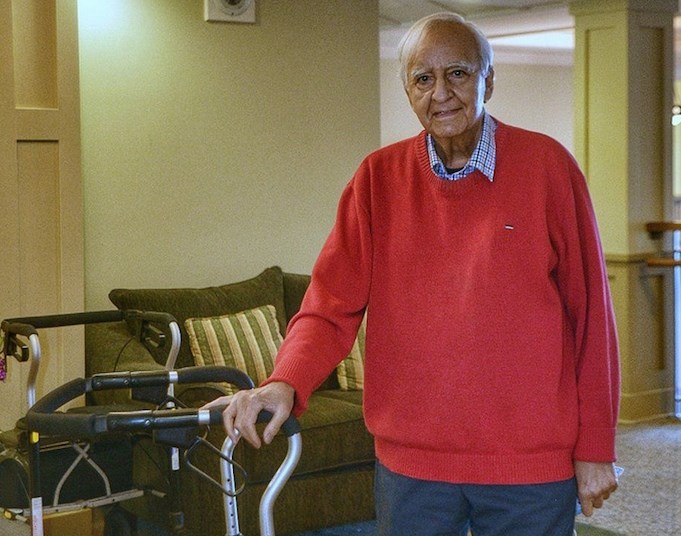
Dr. Max Zahir at his home at Berwick on the Park.
Image Credit: Michael Potestio, Local Journalism Initiative
February 27, 2021 - 3:30 PM
Memories of days past helping fight the smallpox epidemic in Pakistan during the 1960s are still fresh in the mind of retired Kamloops pathologist Dr. Max Zahir.
That effort seems all the more relevant now as the world grapples with the COVID-19 vaccination rollout in a bid to end a pandemic that, in a year since its detection, has infected more than 100-million people and killed more than two-million.
Zahir, an 84-year-old Berwick on the Park resident, spent a year between 1966 and 1967 working in Lahore, Pakistan, to help snuff out smallpox — the contagious disease known for its rash of blisters that was successfully eradicated through vaccination by 1980.
Decades earlier, the World Health Organization had initiated a global campaign to rid the world of the disease, which was still endemic in countries across Africa, Asia and South America — a campaign that was intensified in the late 1960s.
The strategy to address smallpox outbreaks in Pakistan, Zahir recalled, was to identify cases and rush to immunize that person’s close contacts before the virus could spread
In Pakistan, that was aided by elected “headmen” from villages around the countryside who would contact the government to report when a case of smallpox came to light.
The headmen would then take the medical teams to the patients and all the neighbours, family and friends of the individual were given the vaccine via a gun-like injector.
“The epidemic was raging,” Zahir said. “I remember going from village to village and I saw people lying on string beds in the mud huts just covered with blisters.”
It was an overwhelming sight — one that had Zahir wondering how the disease would ever be exterminated.
“The eradication of smallpox, it was [an] absolutely incredible achievement,” Zahir said.
“At one time, it was thought it could never be done — and it was done. And it was the most devastating infectious disease mankind has ever discovered.”
While Zahir made a few trips into the rural villages to administer the vaccine, he said that work was mostly done by young doctors planning to become experts in infectious diseases.
Zahir’s primary position was studying the disease in the city of Lahore at the Pakistan Medical Research centre (PMRC), which was funded in part by the U.S. government and the World Health Organization.
Zahir, who is originally from Pakistan, went to Oxford University in England in 1959 on a Rhodes scholarship, completing a doctorate in infectious diseases in three years.
He then spent three years training in clinical pathology.
The University of Maryland’s medical school recruited him in 1966 as part of a group of doctors who were to work on the eradication project in Pakistan.
In Lahore, Zahir was put in charge of a lab at the PMRC.
His main focus was determining why some severe cases of smallpox developed blood-filled blisters rather than pus-filled ones.
“That’s a terrible sight, when you’re head to toe with pustules filled with blood,” Zahir said.
He found the answer studying blood samples of smallpox patients, determining that the virus interfered with the blood clotting process, causing a person to bleed into the blisters — findings which he published.
“Part of eradication is to understand the disease,” he said.
Zahir — who had returned to his home country in part to be close to his aging parents, who lived in Lahore — wanted to stay longer, but after a year, the University of Maryland offered him a job as a full-time faculty member at the Baltimore university.
He and his wife, Maureen, spent four years in the U.S. city before Zahir desired a change of pace, wanting to work as a pathologist in a community hospital.
The plan was to move to B.C., with which Maureen was familiar, having worked there previously as a nurse.
However, Zahir said, the province wasn’t granting licences to non-Canadian specialists at the time. Such licences were being granted in New Brunswick, so the Zahirs spent two years in the Maritimes before Max applied for a job in Kamloops.
He spent more than 20 years as a pathologist at Royal Inland Hospital before retiring in 2003.
Though he’s had a lengthy career, that year fighting the last significant epidemic of smallpox in Pakistan sticks in his mind.
“It was an incredible experience,” Zahir said.
On May 8, 1980, the 33rd World Health Assembly officially declared the world free of smallpox.
The eradication of the disease gives Zahir hope the efforts to rid the world of the COVID-19 pandemic today will be successful — some 40 years after smallpox was wiped put.
That effort is considered the greatest achievement in international public health, according to the U.S. Centres for Disease Control.
Smallpox had been around for centuries and, by the mid-20th century, had been eradicated in North America and Europe.
Caused by the variola virus, smallpox killed about three of every 10 people who caught the disease.
Many survivors have permanent scars over large areas of their bodies.
— This story was originally published by Kamloops This Week.
News from © iNFOnews, 2021